New Camaldoli Hermitage Silent Retreat
December 05 to 11, 2021
Journal
“I live in that solitude which is so painful in youth, but delicious in the years of maturity.”
Albert Einstein
Sunday 05 DEC 2021
Since 2017 I have been making one or more trips each year to the New Camaldoli Hermitage.
The Camaldolese are a branch of the Benedictine order that was founded by St. Romuald in the late 10th century. The New Camaldoli Hermitage in Big Sur was established in 1958 by two monks from the original motherhouse located in Camaldoli, Tuscany.
The hermitage is about 40 miles north of San Simeon on Highway 1. Just before Lucia, watch for the wooden sign and take a right onto a narrow two-mile road that winds up the side of the mountain to an elevation of about 1,300 feet. The bookstore, which also serves as the office, has limited hours but it is open to drop-in visitors who are not overnight guests.
The church there is like no other I have seen before. It is small (seats maybe 50), simple, of contemporary design, and quite beautiful in all these attributes. I like to go into the rotunda where the altar is located to meditate/pray when the monks are not holding services. You seldom encounter anyone else during these times, and it’s an ideal space.
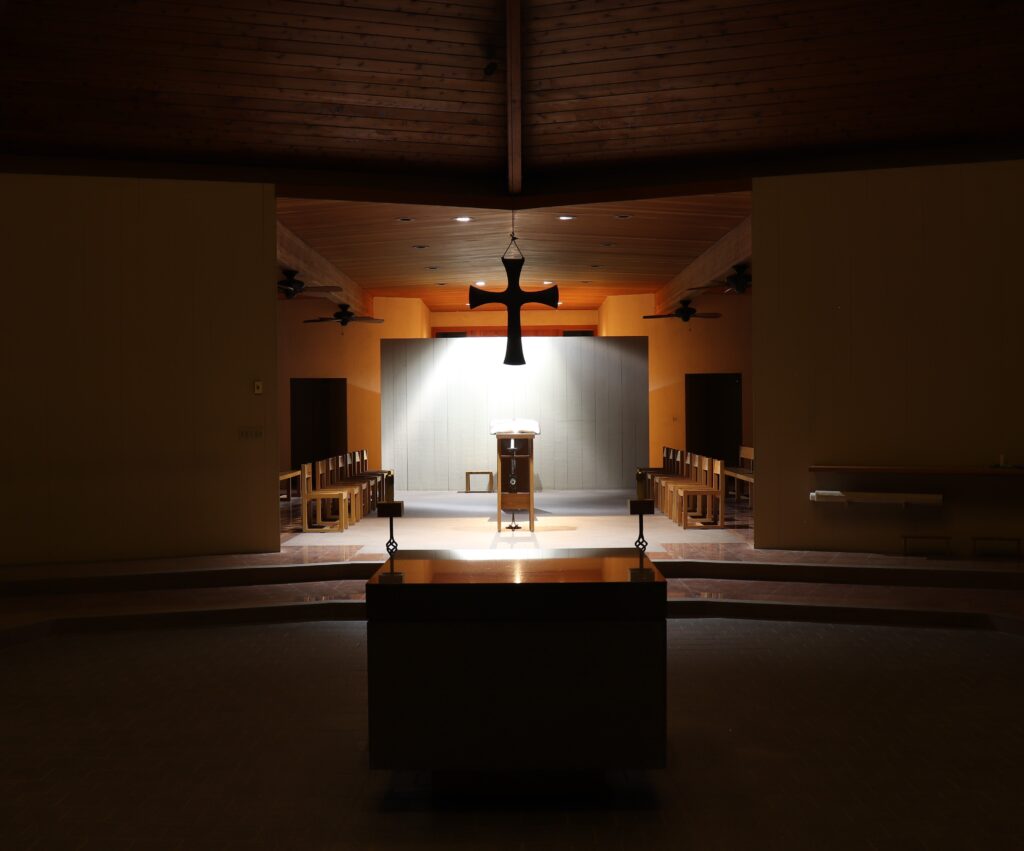
Inside the church looking from the rotunda, into the area where the monks and guests are seated during services.
Another goal of this trip was to visit my brother Kevin’s daughter, Alysen (Aly) and her family in Atascadero. Given that Atascadero was not far off my intended route to the Hermitage, I thought it would be nice to visit them on the way up. They agreed.
Aly (30) and her husband Cody (34) were married in Atascadero on October 16, 2010. They have two children Noah (7 as of 2021) and Eleanor who turns 1 on December 17, 2021; which happens to be the 3rd anniversary of my mother (Louise) passing away.
This morning, just before reaching Hwy 166, I got a text from Aly that said that Eleanor was sick, and could I try to come by for the visit on my way back home. I exited the 166 and parked in the truck stop to reply that I understood, and that I would contact them on my way back down. I’m hoping that I can at least drop off the holiday chocolates that Elsebeth sent with me to give to them.
With this news I decided to take a longer, out-of-the-way route north. I love traveling on backroads and seeing new sights. It’s hard for me to pass any sideroad without wondering what there is to see that is just out of sight. After looking at Google maps, I chose Bitterwater Road; a route I had never been on before and one that weaves in a northwest direction between highways 58 and the 46.
The road passes through a couple of huge open-range cattle ranches, where I saw very few bovines. It was mile after mile of gently rolling dry featureless hills set against a bright blue sky, with only a tree or two around the few houses and barns that were in this vast area. It took much longer than I anticipated, but was worth it.
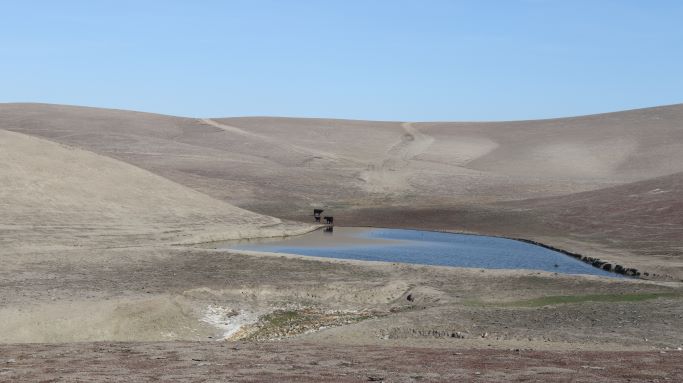
Made a quick stop at a market in Paso Robles for a few supplies, and hit the road again. I called Mia and Elsebeth from an overlook on highway 46 that is between Paso Robles and Cambria from which you can see a spectacular panoramic view of the coast including Morro Rock. I told Elsebeth and Mia how much I Loved them, and told Mia how much she had been on my mind during the drive and that I was thinking how proud and supportive I feel toward her and her life and the educational path she has chosen.
There was a time when I was concerned, and openly critical, about her changing her major from physics to history. I have come to think and feel differently about it. She deserves to make her own way in life with her parent’s full support. I don’t think I’ve said that enough, and I have resolved to voice my encouragement and support more often.
It was a spectacular Big Sur day. The view from Hesychia (my cabin or “private hermitage” as they call them) was otherworldly beautiful. Colors were vibrant, and the air so fresh. The sun was beginning to set, and Hesychia has an excellent view of the show. I took out my DSLR and took a few photos. Some turned out to be quite beautiful. Later, after the sun went down, the Moon and Jupiter became the bright spots in the sky.

My view south from the hermitage. The coastline can be just made out through the light fog.
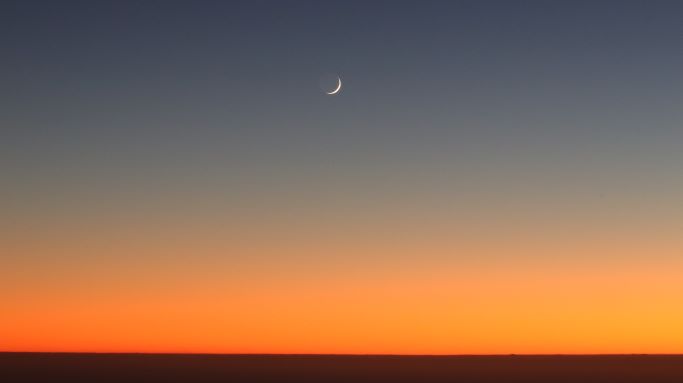
Looking out over the ocean just after sunset with a crescent moon.
Made myself a 3-egg cheese omelet with chopped fried red onion, topped with salsa for dinner. Delicious.
Monday 06 DEC 2021
Woke up just before 4:00 am. Made coffee and started the day.
Hesychia is like a small one room bachelor apartment; a combination bedroom, kitchen, study area, with a small bathroom/shower at one end. This particular accommodation is slightly less spartan than the monk’s “cells”, but is more isolated from everything else on the grounds. The hermitage property is self-contained. Electricity is provided by a generator. There is no mobile phone reception. Guests can use a landline phone at the bookstore to inform family they have arrived safely. There is internet, but it is only for the monks. Guests are not provided the password in order to encourage prayer, inward refection, and contemplation. Water comes from a cold mountain spring.

Hesychia: My place of silence and contemplation for the week.

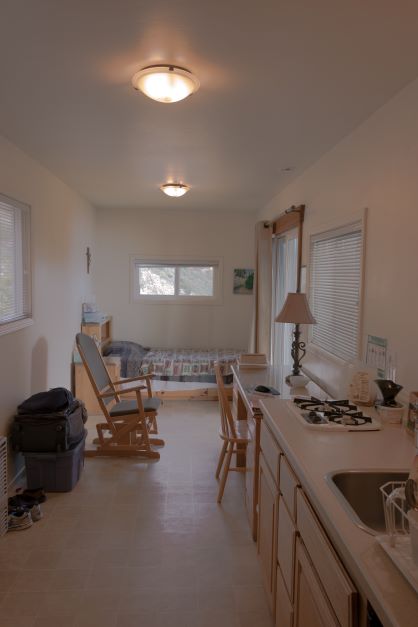
Inside Hesychia. At one end a bed and the other a bathroom. A couple of chairs, a desk and a kitchenette with hotel-size frig. Dishware and utensils are provided.
Showers in this small cabin have to be well planned out. The single control for the hot and cold water must be carefully adjusted, and you should only have it on when you need it. If you don’t push the water control closed when soaping up, you will run out of hot water rather quickly. When the hot water runs out, it does so suddenly, and it is quite a shock of cold. This lesson in hot water management is learned on the first shower.
Had some oatmeal and toast for breakfast, and then went to 5:30 am Vigils.
While I have attended a number of their “preached” retreats over the years, I have only occasionally attended services (Vigils, Lauds, Vespers, and Eucharist).
On one occasion while on a retreat here I attended “Eucharist”. The congregation and I were standing in a circle in the rotunda around the altar. When the call to come up to receive communion was made, I was the only one who did not go up. Having not been an active member of the Catholic Church for many years, I felt that going up to receive would have been inappropriate. I wanted to show solidarity with the others in the room, but if I were to participate, I thought it would be crossing a line. Being the only one not to go up did feel very awkward.
I was raised in a Catholic household, and while it has been decades since I routinely attended Mass, I do recall the format and what the ritual represented. I also served as an altar boy for a few years while going to school at St. Augustine’s in Culver City. To me, these Camaldolise services seem to have little in common with the Mass services I experienced in boyhood. But the main source of my discomfort has more to do with their reading passages from the Old Testament that, for me, seem to be outdated and lacking in spiritual meaning.
In every other way I can think of, I have been impressed with the Camaldolise monk’s spirituality, their open-mindedness regarding interfaith dialog and acceptance. Their preached retreats have been a testament to that.
Here is a description of a retreat I attended in February 2018 titled “The Four Limbs of Christianity” given by the Hermitage prior, Fr. Cyprian Consiglio.
“Our late Fr. Bruno re-imagined the Trinity was the Silence, the Word and the Music and added a fourth element––the Dance. This retreat, we will weave together Bruno’s thought with that of Teilhard de Chardin, Bede Griffiths and Raimundo Panikkar, along with some insights from Transpersonal Psychology, to re-articulate some of the ancient truths of Christianity in a language of dynamism, evolution and challenge for our present age.”
Until I encountered the Camaldoli, I would never have imagined this sort of topic being discussed at a Catholic institution. These preached retreats became a big part of why I keep coming back, and one of my reasons for reconsidering a return to Catholicism as my religious community.
There was another retreat that was given by Fr. Bede Healey, who is both a monk and a licensed clinical psychologist. In this retreat he dealt with the phenomenon of fragmentation in the world (personal, social, etc.). After one of the day’s sessions, I approached him and asked if I could see the artwork that was in their sacristy (room where the priests change into their vestments). He very generously gave me a tour.
Below is a small sampling of the art in the hermitage church. It is my understanding that all of the art was donated to the hermitage, and in some cases by local artists. I do not know the names of the artists, but I did learn a few things about the pieces over the years by talking with the monks.

This painting is a modern work, and reinterpretation of an original work by Russian artist Andrei Rublev (c1360 – c1430) titled “The Trinity”. It’s about 2’ x 3’, and is the first thing you see when entering the church.
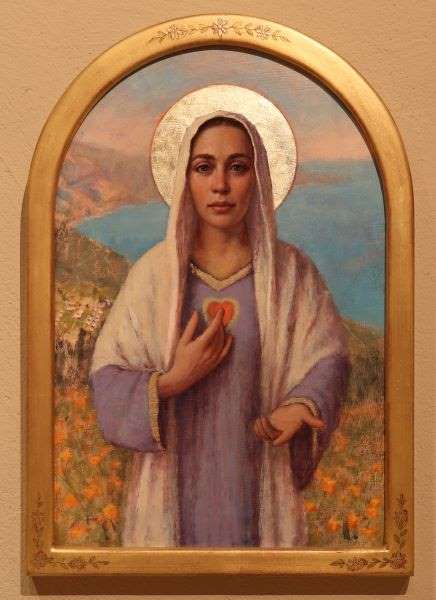
An original painting created specifically for the hermitage is about 18” x 24” and is an interpretation of the Immaculate Heart of Mary. The background in the painting is pictured as being on hermitage grounds looking south. Note the California poppies in the foreground. That is exactly what the coastline looks like from their location. Mary is also imagined as an indigenous native woman of the Esselen tribe (the few descendants of which still live in Monterey County). The Esalen retreat center further up the coast takes its name from this tribe.
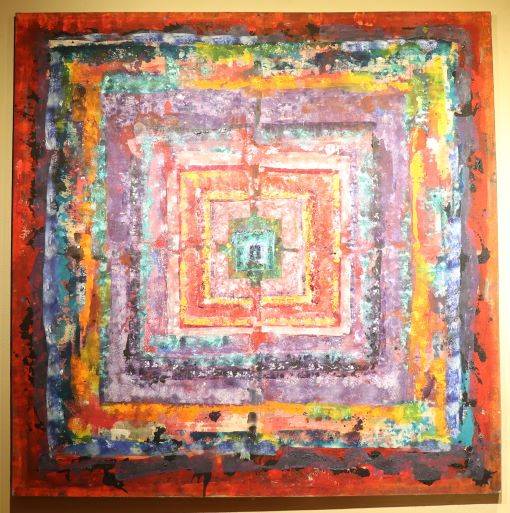
This large painting (about 6’ x 6’) is located inside the church meeting room where they hold the “preached retreats”. It is a modern interpretation of a Buddhist mandala.
Later, I asked Fr. Bede why he chose the work of Donald Winnicott (an English pediatrician and psychoanalyst who was especially influential in the field of developmental psychology) over other theories such as Freud, Jung, etc., as the model for his practice. He said that Winnicott’s work appealed to him both personally and intellectually. For reasons I still cannot explain I blurted out, “Kind of like religions?”; implying that there were other equally valid paths to salvation and union with God other than Christianity. He looked at me with no apparent surprise, and without hesitation he simply answered, “Yes”.
I will never forget it. Between all my past years of practicing Catholicism and fundamental Christianity, I never heard anything but Christianity was the one and only true religion, and that everyone else practicing other religions (or none at all) were going to Hell. That was the message; no nuance or room for other interpretation. In fairness, the Catholics and fundamental Christians I had once affiliated with are not the only religious sect who believe they have sole ownership of the Truth. But they are the particular brands that I can personally speak to with certain experience.
But here is the rub. The liberal theology and philosophy of Camaldoli are hard to reconcile with their prayer rituals that include Old Testament readings (like the Psalms or Judges). In my opinion, these writings have no apparent connection or any relevance to Jesus and New Testament teachings.
Though I have come to appreciate all the world’s major religions (thank you Huston Smith), I feel that not having a specific religious/spiritual practice has left me with a feeling of not belonging to any community. After a time spent with the Camaldolese monks, I have given serious consideration to returning to the Roman Catholic tradition. However, I cannot get past this question as to why the Camaldolise order leans so heavily on Old Testament scripture in their services.
The Camaldolese founding saint, Romuald, has a “Brief Rule” for those seeking silent contemplation. It states, “The path you must follow is in the Psalms; never leave it”. When I read the Psalms, I see the occasional inspirational sentence. But moreover, it speaks of a vengeful god; a god that is a product of an ancient patriarchal culture that has no connection to the New Testament teachings. An example that comes to mind are the passages of Psalms with King David lamenting about being at odds with people who are trying to violently take his land and riches. There are David’s declarations about his close relationship with God and how God strikes “all my enemies on the cheek; you break the teeth of the wicked”. This and other books of the Old Testament seem to embrace such things as misogyny, mass murder, and materialistic wealth.
Granted, that was a different time, and it is the way they saw things back then. However, you still see that same theology today often invoked by those involved in competitive pursuits such as professional sports or preludes to war. Jesus performed miracles in his day, but I do not recall Him ever speaking of taking sides in a sporting event or a geopolitical battle. The Old Testament, while being an interesting historical account or insight into the thinking of the day, is not anything I can relate to as a useful part of my evolving spiritual practice.
Some biblical academics claim that the primary reason why Christianity kept the Old Testament as part of the Holy Scriptures is because of the prophetic messianic references therein lent support for the case that Jesus was the Messiah. Some sources say that there are 47 Old Testament references that support the claim for Jesus as the Messiah. Others, who take a more freehanded interpretation of the text, claim over 3000 references.

The hermitage church Bible.
I had recently read “Belonging to the Universe”. It is essentially a transcript of a conversation between the scientist Fritjof Capra and the Benedictine monk Brother David Steindl-Rast, with additional commentary from Fr. Thomas Matus (a Camaldoli monk). The book was conceived and written during a period of time when Brother David was in residence at the Hermitage with Fr. Thomas. Both were also teachers in residence at Esalen back in that institution’s more egalitarian days 1. This book is now 30 years old, but is as timely today as it was then.
Fr. Thomas is a theological master. He and his contemporaries, like Brother David, and Fr. Thomas Keating, and alike are at the forefront of a new paradigm theology that can hold-up to and partner with scientific discovery and theory.
His life story is extraordinary, and too long to tell here. So, I will simply point to a copy of his CV which I obtained from the internet 2. It provides a glimpse into the depth of this holy man’s intellect, calling, and body of work.
If I could pose a question to anyone of my choice about the use and importance of the Old Testament in Camaldoli ritual, it would be Fr. Thomas. So, before coming on this retreat, I wrote the Hermitage to ask if Fr. Thomas was still there, and how I might contact him. About a week later I got a reply directly from Fr. Thomas himself! I was floored. Did not expect that. His reply was short and sweet.
“Hello, Michael,
Yes, I am here at New Camaldoli Hermitage. I live a semi-reclusive life but share Eucharist and major liturgical Hours with my monastic brothers and our guest- sisters and brothers. I am, by God’s grace, trying to witness to our faith and calling in my quiet and secluded existence, according to our spirit from Saints Benedict and Romuald.
God bless you always,
-fr. Thomas”
It is interesting to note that as a young man Fr. Thomas was originally drawn to yoga, and then converted to Catholicism when he was 19. Years later, he spent some time in India studying with fellow monk Bede Griffiths at the Catholic “ashram” that Bede founded.
The email from Fr. Thomas was nice, but it read like he was out of the public eye and probably not be open to meeting in person. I wrote back to let him know how much I enjoyed his contribution to the book, and that I would be staying at the Hermitage this week. Part of me hoped that he would reply with an invite to chat, but a reply never came.
Later in the day, when I walked into the Hermitage bookstore, I was greeted by Fr. Isiah. I asked if he had any titles by Thomas. He pointed me to one of his most famous; “Yoga and the Jesus Prayer” (1985). I bought it and a couple other books as well. While in there I overheard a man inquiring about arranging counseling session with a monk.
I returned to my cabin to read and write. But I could not get this whole thing out of my head. I kept thinking, I’m here, why not go for it and try and get this question resolved. But I was feeling timid and reluctant to do so. Ultimately, I decided to just go for it.

Some locals. California quail.
Returning to the bookstore, I asked Fr. Isiah if I could schedule a meeting with one of the monks. He said he would look into it and told me I would be notified when a day and time was available. I thanked him and turned to leave. I was just about to open the door when he called out to me and said that it looked like he could arrange for me to meet with someone tomorrow (Tuesday) at 2:00. I remember feeling that this sudden availability of an opening felt a little odd. But I was excited that someone was available, and I wanted to gather my thoughts before the meet.
Later in the day, I had a wonderful 40-minute meditation in the church rotunda. It was all about seeking God, understanding and giving thanks for my life and all that I have; home, family, friends, teachers, food, health…gratitude for everything.

View from near the top of the two-mile road up from PCH to the hermitage.
I spent the rest of the night reading and thinking, and stayed up a little later than I had intended.
Tuesday 07 DEC 2021
I slept in till about 7:00. Must have gotten about 8 to 9 hours sleep. I rarely do that.
Coffee, toast, and oatmeal for breakfast, and a quick shower.
Did more reading in preparation for my 2:00 meeting. Somewhere in between all this I took a long walk.
At 1:40 I hiked up to the church for my appointment. I wanted to be early rather than late. I brought a book with me to read while waiting, but I was having a hard time focusing on the words. My mind kept wanting to rehearse how I would approach the subject. At 2:00 I heard someone walk in and I looked up to see a monk standing facing away from me toward the altar saying a short prayer.
When the monk turned around, he had a medical mask on (the days of COVID), yet I could see it was a familiar figure. Just about the time I had figured out who it was, he introduced himself, “Hi, I’m Father Thomas”.
Synchronicity, a gift from God/Universe, or perhaps it was Father Isiah’s intuition when I asked about Thomas’s books and he put the picture together? Whatever the case, it was an unexpected opportunity that took me by complete surprise. For the first minute I was nervous, so I kind of fumbled my words and acted a bit awkward and nerdy. I had to gather myself as he directed me into the small anteroom where they held these one-on-one meetings.
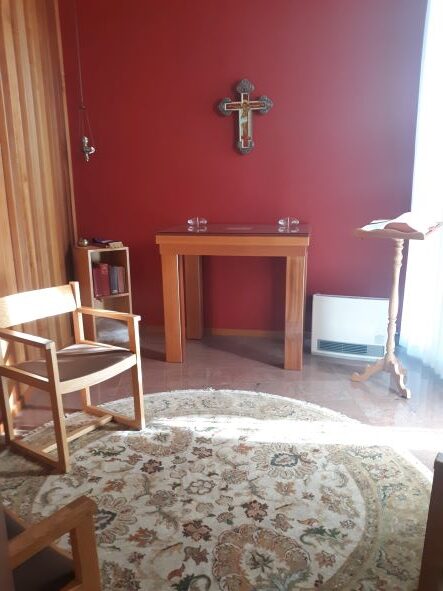
Skipping all the preliminary lead-up stuff that I had been repeatedly rehearsing in my head, I got right to the bottom line and asked the question. Thomas got right to the answer, and then some.
Note: Fr. Thomas will be 82 years old in February (2022).
He was not for loss of words. I was sitting, one-on-one, with this learned scholar as he gave a discourse on how the Bible was written, how it is to be interpreted, the fine nuances of language and translation, issues of authorship, and related cultural and theological history. As I asked follow-up questions, he picked up on my interest, and he seemed invigorated at the fact that I had some knowledge of early theologians such as Origen of Alexandria (184-253 AD); who Fr. Thomas emphatically told me he considered to be a genius.
I give credit to the William Neidinger lecture series videos I have been watching on Prime for my intro into the academic history of the Bible and development of Christian theology. Had I not watched these I probably would not have stood a chance of keeping up with Thomas’ rapid-fire download.
There were moments during the short hour I had with him that sounded like he was rambling; and given his age, I was ready to let it go at that. But as I listened I realized he was weaving together the essential bits of the corpus of information that is needed to frame the answers to my questions in the short amount of time we had together. At times, in a moment of inward focus to craft a precise sentence, he would close his eyes while holding out his right hand toward me, palm down with fingers spread in emphasis, like he was reaching out to imprint a crucial point onto my mind.
I got the impression that we could have gone on all day. We both seemed to be enjoying the exchange, and at one point I responded to one of his points with a witticism that made him laugh out loud. The discussion went well beyond my initial question, and our time together was stimulating and delightful. The hour went by in a flash.
His answer to my question was essentially this. People have forgotten that the style back in the day, for both oral and written word, was primarily allegorical. Yes, there are some factual historical accounts in some of the Old Testament books, but others, like the Psalms, are writings for which we must look for the hidden meaning. Thomas sees the Psalms as not a conflict between King David and his enemies, but as a metaphor for everyone’s own inner conflict between their “light” and their “shadow” (good and evil if you like).
At first, this explanation sounded like a reach; a work-around of sorts in order to keep a long-standing liturgic tradition alive by reinterpreting it’s meaning through metaphor. However, I reminded myself that Fr. Thomas is a monk who has spent the better part of his life in contemplation, meditation, and prayer. He is a mystic and, what I have gathered from his writings, he has experienced profound ecstatic spiritual states; what some would describe as non-ordinary states of consciousness (cosmic or Christ consciousness). After decades of study and hermitic practice, he sees all things through an enlightened Christian-based paradigm. Thus, he perceives the Divine in all things; even in ancient texts for which I find no inspiration.
A thousand years ago there were other great minds like the Islamic scholar Averroes who wrote of the “double truth” (logic vs allegory), as well as the Jewish philosopher Maimonides who authored the “Guide for the Perplexed”. These folks grappled with similar topics. The deliberation over rational/factual vs allegorical interpretation is as old as the Bible itself, and will most likely occupy the thoughts of academics and mystics for ages to come. Still, I am less than convinced that the Old Testament writings have value to most people in this day and age, and can quite possibly confuse or distract most from Christ’s central message.
Fr. Thomas Keating, founding member of Contemplative Outreach and one of the Catholic priests who developed Centering Prayer (a form of Christian meditation), sums it up best in a single sentence when he wrote,
“Our scriptures are really based on a view of God that is patriarchal and limited by the culture of the time, and it just doesn’t work anymore.”
Toward the end of our conversation, Fr. Thomas did go on to talk about the evolution of Catholicism, and acknowledged that changes to the catechism of the Church occur very slowly. He pointed out that Vatican Councils do not occur very often. Vatican II was held in 1962, and the one before that was held in 1869.
Thomas said that the 20th century scientific discoveries, as well as new information and attitudes regarding the Bible, had forced Rome to take a hard look at things. Vatican II (actually named the 21st ecumenical council of the Roman Catholic Church) grappled with these considerations, and the results are regarded as a major shift toward more progressive thinking within the Church. He also noted that there were other important subjects that the Church was not yet ready to accept like women in the priesthood, marriage for priests, and acceptance of non-traditional sexual orientations. Clearly, Thomas was of a mind that it was time that these things be accepted.
Clergy like Fr. Thomas, along with progressive nuns like Wendy Beckett and Ilia Delio, say that the church will eventually come around because acceptance of people and practices are acts of Love and, after all, God is Love. The big question is, will the Church keep up with the ever-quickening pace of social, scientific, spiritual discovery and changes, and adapt fast enough for the Church to remain socially and theologically relevant? After all, it seems change comes to society more quickly than within institutions.
Theology must necessarily evolve beyond the ancient perspective, and in doing so make course corrections. Case in point; Galileo Galilei.
In 1633, the Roman Catholic Inquisition forced Galileo to recant his theory that the Earth moves around the Sun. It was not until 1992 (359 years later) that the Church finally admitted that he was correct.
Debates about the Old Testament aside, I ask myself, is Catholicism a good fit as my religious identity?
The better question might be, do I need any religious identity at all? As Fr. Thomas writes in his book, “Yoga and the Jesus Prayer”,
“The search for religious identity and for the objective certitude that goes with it is part of human nature and hence in itself is positive and often necessary for maintaining one’s sanity. But the search for religious identity is not the same thing as the spiritual search. Being aware of one’s religious roots is comforting, but it is not identical either with faith or the experience with God. Faith, when it is authentic, takes me beyond security into a realm where peace may indeed be found, but only in an unmoored drifting into the vast sea of reality.”
“I cast my anchor of my life down, and I let its line run deep into the unfathomable God on whose bosom I float. In this situation, two certitudes reassure me: the one, that it is not madness to be afloat in God, and the other, that I am not alone on this sea.”
The words of a true mystic.
I wonder, can my search bring me to a place “beyond security” thereby making religious identity unnecessary?
Near the end of our conversation, I asked Thomas directly, did he consider himself a mystic? He said that he would answer that question with a quote from his “good friend” Brother David Steindl-Rast;
“A mystic is not a special kind of human being; rather, every human being is a special kind of mystic.”
Our meeting ended with me asking for his blessing, which he did by asking God to assist me in my spiritual journey.
I had much to think about.
“Someday, after mastering the winds, the waves, the tides and gravity, we shall harness for God the energies of love, and then, for a second time in the history of the world, man will have discovered fire.”
Pierre Teilhard de Chardin
“The religions start from mysticism. There is no other way to start a religion. But I compare this to a volcano that gushes forth …and then …the magma flows down the sides of the mountain and cools off. And when it reaches the bottom, it’s just rocks. You’d never guess that there was fire in it. So, after a couple of hundred years, or two thousand years or more, what was once alive is dead rock. Doctrine becomes doctrinaire. Morals become moralistic. Ritual becomes ritualistic. What do we do with it? We have to push through this crust and go to the fire that’s within it.”
Br. David Steindl-Rast
I have much Love and admiration for people like Thomas who have broken through the hard rock to find the fire; be they Catholic, Hindu, Islamist, Jewish, Buddhist, or those of indigenous religions.
Thomas knows he is not alone on this sea. He and his fellow voyagers commune together on their Santa Lucia mountaintop refuge, along with their network of likeminded groups and individuals from across the globe.
To date, the community I feel most at home with are like-minded people who focus on personal/spiritual development via a variety of mystical modalities, and who embrace and welcome people from all religious traditions and who integrate these practices into their spiritual life. But routinely meeting up with such like-minded people for more than just a couple times a year has so far been unrealized. Not complaining. Just wishing.
As Brother David Steindl-Rast wrote;
“I might just as well rise to this challenge and become that unique, irreplaceable mystic that only I can become. There never was and never will be anyone exactly like me. If I fail to experience God in my own unique way, that experience will forever remain in the shadow of possibility. But if I do, I will know life by the Divine life within me.”
On the occasion of his 90th birthday, Brother David was asked how he has managed to flourish within the Catholic tradition, and extend beyond it, and not get kicked out. He replied,
“I’m very blessed to stand in a tradition ever since I was a child in which I feel very comfortable. I was born into that tradition. I was raised in that tradition – and can make my own expressions of that Christian tradition – a particular Christian tradition. All the archetypes speak to me, so I’m very much at home in the Catholic Christian tradition.”
I suppose it is the same for me, and that David’s sentiment is a fairly good expression of why I was comfortable enough to have another look. He goes on to say,
“First of all, Catholic already means ‘all-embracing’, so if you are really Catholic you ought to open to everything else and everybody else. I’ve come to look at all the spiritual traditions in the world as so many expressions of one basic human spirituality. I like actually to call it human religiosity. But the word religion doesn’t have good press these days because we usually think of religious institutions. I don’t mean religious institutions. The word religion emphasizes “the tying” – religare – tying together bonds that have been broken.”
“Spirituality is aliveness – that’s what the word means. Aliveness. And religion means tying the bonds that have been broken – that is the bonds to our own true self, the bonds between us and all other humans, all other plants, animals, the whole universe, the whole cosmos that are broken and damaged and need to be fixed. And our bond to that great mystery which we call Life or God.”
(See also MAPS podcast #5 – Bob Jesse on “Religion”)
Somehow, Brother David has managed to not go the way of Pierre Teilhard de Chardin and be ordered to muzzle himself and have his books banned. A person of Brother David’s popularity and wisdom has learned how to take the temperature of the room and navigate Rome. And now at 95 (as of DEC 2021), I’m sure he is even less concerned if Rome has a problem with what he says or writes.
So, yes, I can find this thinking up here on the mountain with the Camaldolese (and in the books I read), but what about my neighborhood Catholic church in the San Fernando Valley? That seems very unlikely.
Flashback.
While pondering all this, I reread my notes from my first stay at the Hermitage. Like this one, it was for a week-long solo retreat in the very same cabin, Hesychia. Here is what I wrote in my Journal during that first stay.
“…I stopped by the hermitage bookstore. A resident hermit, Father Thomas, was working the store. At first, he was a bit reserved, but then I started asking about how they select the rather liberal leaning selection of books in the store. It was like turning the ‘on’ switch. He talked and talked, and I enjoyed every minute of it. I learned that he and a few of the other monks had visited Huston Smith in the year before his death. He described him just as he comes across in his books, and I could see a look of admiration in his eyes.”
That was in September of 2017, and it was now a surprise to read. I had not remembered that I had met him before. At that time, I had no idea who he was or the measure of the man I was talking to, though I unknowingly got a glimpse of it.
Shortly after this first visit to the Hermitage, I made contact with a very special kind of mystic, Colleen, and almost exactly two months after this first stay, I had my first session with her. This would be what I now know was my first step (more like a quantum leap) toward becoming my own “special kind of mystic”.
Feeling so much gratitude for these extraordinary people.
Wednesday 08 DEC 2021
Another fine morning. Feeling pretty good and in need of catching up on my journaling. So, I wrote most of the day. Visited the bookstore to take a couple photos of some Christmas ornaments that I thought Elsebeth would like. Then later in the day I drove down the road where I could get phone reception to check in with the girls. Had to go a bit further than I expected.
Along the drive I spotted a Peregrine Falcon sitting atop a tall evergreen. Of course, I did not have my DSLR with me. They do live along this stretch of coastline, but spotting one, in particular seeing one that is perched, is pretty special.
Earlier in the day I was walking down from the community kitchen when I saw what looked to be either a male Coopers or female Sharp Shin dive into the canopy of a large Oak tree. A split second later, about six or seven sparrow-sized birds burst out in all directions. I paused to see what might happen next. Did he/she get one? Nope. It flew out the other end of the tree a few moments later – empty-taloned – and landed in a tall evergreen about a hundred yards away. I thought about going over to check it out, but I figured it was probably a little frustrated and hungry. Best to just let it be.
I have always considered special bird sightings as a good omen; auspicious (re augury of ancient Rome).
Thursday 09 DEC 2021
Just as predicted, it rained last night, and on into this morning when I got up just before 4:00. It was cold.
Made myself a wonderful egg scramble. Still have more eggs than I think I can use before I leave. We’ll see.
The rain gave this place an even more quiet atmosphere than it usually has, if that’s actually possible.
Did more reading and more writing.
The rain has passed and it is now a windy sunny day with great big billowy white clouds all around. Feels wonderful.
Went up to the church and had a very deep 40-minute meditation in the rotunda. Afterward, I felt a lightness of mind and body, and completely at peace and in the moment. I slowly and casually walked back to my cabin feeling like I was aware of every single thing in my scope of view. For a brief moment I thought of work – for the first time since I arrived – and I just kind of chuckled to myself. In less than a second, I happily let all thought of work go, and had not thought about it again until writing these words.
Went to the bookstore to buy the handmade Christmas ornament that Elsebeth and I like; it’s called “Star of Bethlehem”. It’s made of brass, copper and tin, and is in the shape of a star with a heart in the middle. There are colored translucent beads hanging from the points of the star. It will make a beautiful and memorable official family 2021 Christmas ornament. While there I took the opportunity to buy two more of Fr. Thomas’ books, and a box sampler assortment of petite truffles for Betta and Mia; made by the Brigittine monks in Amity, Oregon.
I have completely fallen into ‘Hermitage Mountain Time’; there is not a rush to anything in my entire body and mind. Near the end of the day, I took the slowest of walks down the long Hermitage access road to catch the sunset. Walking, taking little baby steps in slow motion. Looking down at my feet, I could feel each individual step and was memorized by them. I had the sense that I was finally walking at my own true pace. It felt good. Not a sound was made by my feet as they contacted the ground, like I was walking on air. Time stood still. My heart-centered eyes saw so many beautiful things. Had my DSLR with me, and I tried to take photos of things that I saw while wondering, would the digital image capture the awe as well as the light?
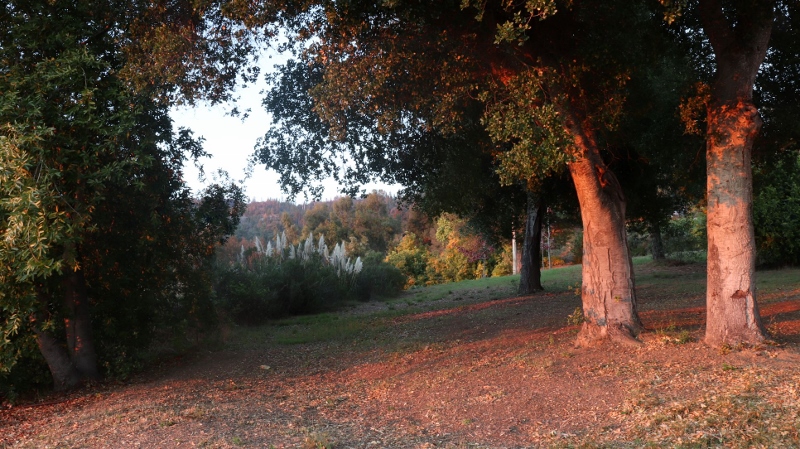

This evening I read Chapter 1 of Fr. Thomas’ book, “Yoga and the Jesus Prayer”. The chapter is titled, “The Way of Integration”. The integration he is referring to is that of “flesh and spirit”. At first, I thought that it was not the same “integration” we speak of in deep spiritual work. I was wrong. It was very much the same, just in different words.
I sit here in front of this keyboard contemplating the content of these first 17 pages of this small book. Previously, I quoted a piece of the chapter under Tuesday’s notes above. But that was when I was only up to page 5. It’s thick material. When I finally got around to reading the rest, it blew my mind.
Fr. Thomas was not raised as a Catholic. His first spiritual practice was Kriya Yoga at age 18 while attending Occidental College in Los Angeles. He describes very specifically the day things changed for him; Friday June 24, 1960 at about 8:30 pm.
“I began that evening’s meditation as a disciple of Yogananda and a believer in the reincarnation of souls; in an instant, in which I seemed to touch eternity, I was a Catholic and a believer in the resurrection of the flesh.”
It’s important to note that Thomas read the works of Yogananda who made reference to Christian mystics like John of the Cross.
Thomas describes his journey to find the best path to bring these two practices (Yoga and Christianity) together into the clearest and truest practice possible.
“Since I cannot undo this search without undoing my faith, I cannot live my Christian identity except as a man who came to be a Christian and a monk by reading Hindu scriptures and practicing Yoga.”
He found a closer approximation for Christian mysticism in Eastern Orthodoxy, in the form of Hesychasm (for which the name of my cabin, Hesychia, is derived). He then goes into an analysis of how Yoga can support his Christian practice; via Hindu Tantrism (going into Kundalini yoga).
“Tantrism seems to imply a view of human existence closer to a Christian ‘incarnate’ view than that of any other yogic school.”
He then goes into describing, in the most remarkable terms, his “experience” and how it works with his faith. I have read and listened to people attempt to describe their own mystical state experiences, and they are all relatable, because I have been there and they ring true. Nevertheless, verbal and written descriptions always fall short, because it is impossible to completely describe the ineffable tidal wave that is the ‘experience’. In these practices, we go into them with an intention. We may not always find or encounter the answer or path we had intended, but very often we do. For Thomas, the intention was/is all about the faith.
“I seek to understand my experience in accordance with the objective content of the faith”
He then “submits” his experience to loving, selfless scriptures, like the Sermon on the Mount, to see if his experience is “bearing fruit in action, as an authentic sign of the Holy Spirit’s grace in me”. He frames his experience in Christian terms, but it is essentially non-ordinary state mysticism in every respect.
“…faith and the experience and understanding that flow from it are always an act of adoration, a prostration of my total being before the Inaccessible and Unknowable One who yet knows me, enters my soul, and thus turns my unknowing into knowledge, however obscure it may be.”
These words of Thomas describe something very familiar and, come as closest to any I have ever read or heard, that describe a key element of the experiences that I have had.
He goes into describing the ‘experience’ in more detail. I cannot do justice to his incredible writing, so one must simply read it for self. But, to understand or recognize what he has written, I would think that one would first to have to have had such an experience. He does his best to try and give a description and explanation to the reader, but even with my first-hand knowledge I had trouble getting through some of his conceptual passages. His vocabulary is beyond mine. I will definitely mine this chapter again when I return home, and have access to on-line references.
The last part of this first chapter he calls “Experience and the Language of Symbols”. He hits all the high points in just three pages; Carl Jung, the collective unconscious and all.
“Because experience is non-conceptual, it is consequently ineffable. However, all experience points in some way to the structures of our existence as thinking beings embodied in the world. For this reason, I can communicate my experience to another person on the basis of our shared existential context. This communication is accomplished primarily by symbols.”
Of note, transpersonal psychotherapist and consciousness researcher, Ralph Metzner wrote extensively on “humanities common language” of symbols and their relationship to human transformative spiritual experience (“The Unfolding Self”).
Friday 10 DEC 2021
Up before 4:00 again. There is only the faintest hint of light over the distant mountain tops to the east. The stars are still out, but different ones from those I went to bed with.

Dawn at the Hermitage.
I did some reading and writing, and watched the skyline above the mountains change colors as the sun came up behind them. The sunrise here is different. Because of the mountains, you get a show of all the colors long before you actually see any sun.
In the early morning the air tends to come from inland and toward the sea. So, sometimes you get a whiff of the diesel exhaust from the Hermitage generator. This does not last long, and by this time of day (7:24 am) the air has changed and there is such a light breeze that it sounds like stillness. Later on, the sound of distant breaking surf gets replaced by the winds singing their OM through the leaves and needles of the trees.
7:38, and the sun has just come over the mountain. Time for breakfast!
I have brought photos of my loved ones with me. I get a big smile on my face every time I look at them. One is an all-time favorite of Betta that I took a while back. She looks so natural, and she has that wise, loving Betta look on her face.
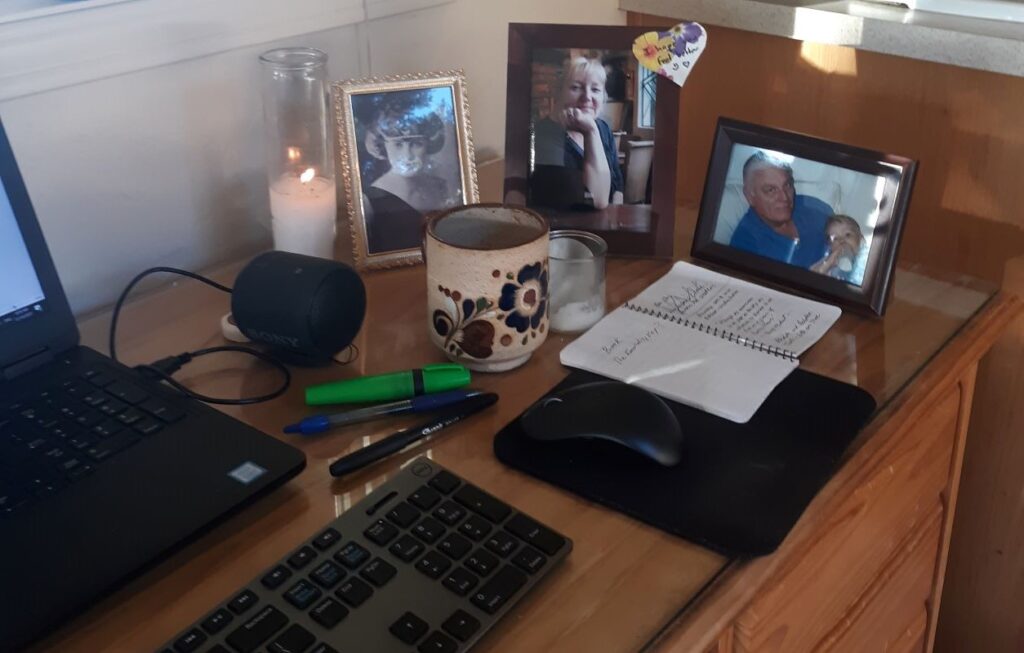
Yes, I feel that they are here with me. So much so, that occasionally I hear them speak to me. Just this morning as I was putting some salsa on top of my freshly made egg scramble, I could hear Betta say in my head, “Don’t you want some toast with that?” If she were here, she would have just gone ahead and shown me the ‘right way’ to have breakfast and made the toast, and we would have eaten together out on the porch listening to the birds. Afterward, as I was consulting the daily church schedule so as to time my rotunda meditation between services, I heard her say, “You’re not going to leave those dirty dishes, are you?”
Well, I didn’t make the toast, but I did do the dishes. 😊
One of the things that always happens on these solo retreats is that I really miss home the first day or two. Then I get into a rhythm of reading, walking, writing, meditating, and all, and I begin to feel very much at home here. I still miss everyone, but I find peace and happiness in the solitude and contemplation, and the amazing display of nature all around me.
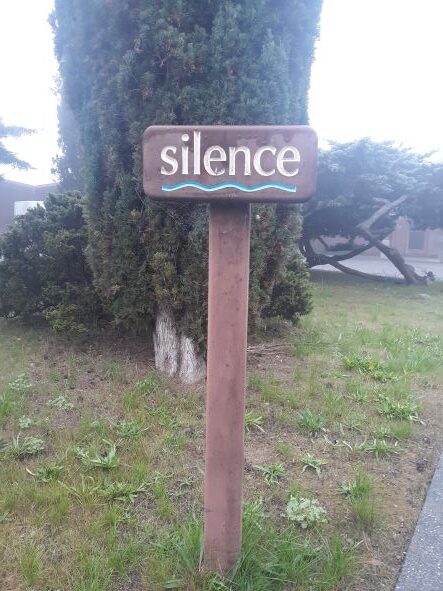
And there is the blessed quiet. There is no quiet like the quiet here on the mountain. I suppose that is because while there are other people here, they all know that most of the grounds here are designated as areas for strict silence. When you pass another, there is only, if anything, an exchange of smiles and a wave or the nod of the head. I know of no other place where you can be around other folks like this and not hear any voices, but you can still feel a sense of community.
By the end of the stay, I am torn between staying in this remarkable and beautiful place, and being back home. This is where I am now. I will be coming home tomorrow, but it will be a bittersweet departure. Tomorrow, somewhere between here and home, I will feel the pull of my Loved ones and I will step a little more firmly on the gas pedal as my heart begins to ache with anticipation at the thought of hugging my girls again.
In time, I will start planning my next visit to the hermitage.
Postscript June 2022: I have made reservations for a week solo stay for the second week of November, in the same cabin.
Saturday 11 DEC 2021
Woke up at 3:00 am on the dot without the alarm. Half-slept for another hour, got dressed and had coffee.
Went outside for one last look at the star show. You don’t see this many stars in the city.
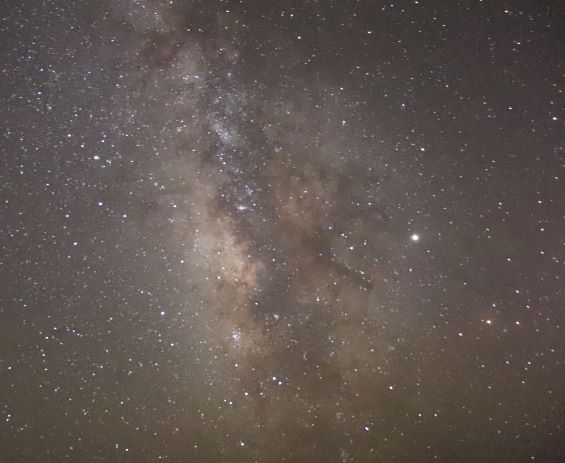
Above, a photo I took of the stars on a previous trip to the hermitage. The dark cloudy area is actually looking at the center of the Milky Way, the galaxy that includes our Solar System. A long exposure was used to bring out the detail.
High out over the dark ocean are the three stars that make up Orion’s belt; Mintaka, Alnilam and Alnitak. They are so bright, and they appear to be perfectly lined-up and evenly spaced apart. But, their appearance from Earth can be quite deceiving, as there in an enormous distance in distances between them and Earth. 3
There are people who study the stars their entire life, and yet they will never get anywhere near them; even if we could travel at the speed of light. Outer space holds many mysteries, and I am as curious about the universe as the next person. But I have to wonder; what will we really gain by spending so much time and fortune in journeying into outer space?
While I do not believe that the answer to the problems here on Earth will ever be solved by traveling to other planets, there has been one unexpected positive side effect from humans going into space.
In the “Dead Poets Society”, professor John Keating invites his students to come to the front of the room and stand on his desk. He tells them, “I stand upon my desk to remind myself that we must constantly look at things in a different way. The world looks very different from up here.” Indeed, it does. Such a simple act can produce an odd and often times eye-opening view of that physical space we occupy. So too it is with outer space; only a lot more profound. Many who have gone on space missions have reported having a transcendent experience when looking at our planet from that vantage point.
In the 1980s, the author and space philosopher Frank White interviewed many astronauts about their personal experiences in space. Many told of looking back on the Earth and experiencing an overwhelming emotion that was “beyond words”, and that one would have to experience it to understand it. White named this ineffable experience the “Overview Effect”. Likewise, Bryce Yaden of the Johns Hopkins University School of Medicine – Psychiatry and Behavioral Sciences wrote a paper in 2016 on the Overview Effect from interviews he conducted with space travelers. These people reported that as they gazed at the Earth below them that they underwent a change of mind state in which the most prominent aspects of the experience were appreciation and perception of beauty, unexpected and even overwhelming emotion, and an increased sense of connection to other people and the Earth as a whole. 4
For many, this Overview Effect facilitated profound changes in the lives of the people who experienced it and have described it as “among the deepest and most powerful aspects of the human experience”. For some, this transcendent experience resulted in long-term positive changes in their personal outlook, and has transformed the way they live their lives.
Mystics spend their time in the pursuit of knowledge of inner space but, much like those who have gone to space and experienced the Overview Effect, they are unable to fully describe their transcendent experiences. These have also resulted in long-term positive changes in their personal outlook, and transformed the way they live their lives. Volumes have been written about it, but how many who do not seek this knowledge of inner space will ever read these works, and if they did would they understand?
The preacher and theologian Ralph Sockman famously said,
“The larger the island of knowledge, the longer the shoreline of wonder”.
This is true for the pursuit of knowledge in both outer and inner space. Both seem to be boundless and difficult for most people to grasp, and both very often result in psychological and spiritual changes for the better to those who have had the experience. However, only one of them holds real promise for humankind’s survival, and that one has the advantage of being much more cost effective than the other
NOTE: A seat on a suborbital trip on Virgin Galactic’s SpaceShipTwo and Blue Origin’s New Shepard cost between $250,000 to $500,000; higher orbit trips and journeys beyond are exponentially more expensive. By comparison, journeys of inner space via a variety of proven modalities are vastly less costly, and they are eco-friendly.
Over the past years I have journeyed many times into this inner space, and they have been among the deepest, most powerful, and spiritually meaningful experiences of my life.
I reflect on what a long journey it has been; from the spark created by my good friend Mike Chlebowski, to this past week here on the mountain.
Years ago, I read a book by the evangelical theologian Francis A. Schaeffer. While I don’t subscribe to all of his views, the title of the book has been for me the underlying question to this spiritual journey; “How Should We Then Live?”.
For most of us this means a paradigm shift, a change for the better, a change based in our new way of thinking; based in and upon glimpses of Enlightenment. After each expedition around and into the ineffable, after each reading of a sacred scripture or inspirational/educational/spiritual text, after each meditation and subsequent contemplation, there can be the realization of a new state of being. It is in the wake of the process of transcendence that a transformation should result. The choice to integrate these experiences into new traits of being is the answer to the question, how should we then live? Life is a lifelong ‘rinse and repeat’ of learning and self-examination, and all the while be grateful for what has come and what is, as we “walk each other home”. 5
Even with the backslides and hiccups along the way, we have within us the potential to get better all the time.
By 8:30 I’m packed up and ready to go. I pause for one more moment to reflect on the week, take in the view, and to say my mystic’s prayer; “Thank you. Help me remember”.
Postscript
I did get to see Aly and her family on my way back home. Spent a little over an hour with them at their place in Atascadero. A connection that was a long time coming was made. Looking forward to more visits.
Even after considerable thought, I still have not decided if Catholicism will be my spiritual/religious identity. Certainly, the teachings of Jesus, along with the teachings of mystical Catholics like the Camaldolese monks, will be an ongoing important source of spiritual inspiration and guidance, and their hermitage will remain for me a place of retreat. Like Brother David, the “archetypes speak to me” in a language for which I am familiar, and they now hold a deeper meaning.
This retreat was intended to be the last undertaking in my spiritual agenda for 2021. Prior to this I had spent time with people who facilitate spiritual journeys that explore sacred. These are advanced religious practices, and were all incredible enlightening experiences that surpassed expectations, and they have provided an opportunity to meet and connect with some interesting people.
For now, while I will continue my search for community, I will focus on becoming my own “special kind of mystic”, and getting to “know life by the divine life within me”. And elements of my Christian/Catholic tradition will no doubt be an important part of that.
MMc
++++++++++++++++++++++++++++++++++++++++++++++++++++++++++++++++++++++++++++++++++++++++++++++++
Footnotes
1 In his book “i am through you so i”, Brother David laments the change of leadership and philosophy at Esalen, and points to the death of Esalen co-founder Richard Price in 1985 as it’s turning point; where interests became more corporate and less egalitarian.
2 Fr. Thomas Matus CV
THOMAS (RUSSELL ANTHONY) MATUS, O.S.B., Cam.
CURRICULUM VITAE
BORN: February 22, 1940, Los Angeles, California; U.S. citizen
MONASTIC LIFE AND ORDINATION
1962 entered New Camaldoli Hermitage in Big Sur, CA, 1964 simple vows, 1967 solemn vows; 1970 priestly ordination
ACADEMIC DEGREES
1961 A.B. magna cum laude, Occidental College, Los Angeles, liberal arts, major in music; Thesis: The Chant of the Divine Office
1972 S.T.L. summa cum laude, Athenaeum Anselmianum, Rome, major in ecumenical theology; Thesis: An Existentialist Catholicism: The Theological Methodology of John Macquarrie
1977 Ph.D., Fordham University, New York, major in comparative mysticism; Dissertation: The Christian Use of Yoga: A Theoretical Study Based on a Comparison of the Experience of Symeon the New Theologian With Some Tantric Sources
PUBLICATIONS
Prior to 1984: a number of articles in English and Italian on Holy Scripture, monastic spirituality, liturgical music, as well as two books translated from the French
1984: Yoga and the Jesus Prayer Tradition: An Experiment in Faith (Mahwah, NJ: Paulist Press): a re-elaboration of the dissertation, later reprinted in India; Polish translation Kraków: Homini, 2003
1992: (With Fritjof Capra and David Steindl-Rast), Belonging to the Universe: New Thinking About God and Nature (London: Penguin Books); Italian translation Milan: Feltrinelli, 1993; translated into other languages as well
1993: Salterio monastico canto e preghiera (Bologna: Edizioni Dehoniane): Psalms and other liturgical texts set to music, most of which was composed by the author
1994: The Mystery of Romuald and the Five Brothers: Stories From the Benedictines and Camaldolese (Big Sur: Hermitage Books)
1996: Alle origini di Camaldoli: san Romualdo e i cinque fratelli (Camaldoli: Edizioni Camaldoli): substantially an Italian version of the above, translated by the author
1998: Nazarena, an American anchoress (Mahwah, NJ: Paulist): a biography of Julia Crotta (1907-1990), an American musician who lived as an anchoress at the Camaldolese monastery of Sant’Antonio in Rome from 1945 until her death
1998: Nazarena, una monaca reclusa nella comunità camaldolese (Edizioni Camaldoli, Pazzini Editore): substantially an Italian version of the above, translated by the author
2003: (With Anna M. Pinnizzotto), Duo concertante, Dialoghi tra vita quotidiana e vita spirituale, tra Oriente e Occidente (Rome: Appunti di Viaggio)
2003: Joga i Molitwa Jesusowa (Krakow: Homini; Polish translation of Matus 1984, by Jan Sar)
2004: Bede Griffiths, Essential Writings (Maryknoll, NY: Orbis Books): an anthology with introduction and commentary on selections of Griffiths’ major writings
2009: Ashram Diary: In India With Bede Griffiths (London & Washington D.C.: O Books)
2010: Yoga and the Jesus Prayer [ample revision of Matus 1984] (London & Washington D.C.: O Books)
During these years, the author has continued contributing articles to scholarly and popular periodicals, as well as acts of various academic symposia and similar congresses, in the U.S., Europe, and India
ECCLESIASTICAL APPOINTMENTS
1993-2003: two terms as consultor at the Pontifical Council for Interreligious Dialogue
TEACHING
1977-1982: Lecturer (professor invitatus) at the Athenaeum Anselmianum in Rome in History of Religion (Hindu and Buddhist monasticism) and Spirituality (theology of the spiritual life)
1977-1979: Lecturer (professor invitatus) at the Franciscan Studio Teologico San Bernardino in Verona, Italy, on Hinduism, Buddhism, and Yoga
(1982-1986, resident at New Camaldoli in Big Sur)
1987-2002: Lecturer at the Athenaeum Anselmianum in Rome (as above)
1987-1993: Lecturer at the Istituto Superiore di Studi Religiosi in Florence (History of Philosophy, Ontology, Hinduism)
2008 (Spring Semester): Adjunct lecturer at the Dominican School of Philosophy and Theology of the Graduate Theological Union, Berkeley, California, course on Monastics In Conversation: A Contemplative Approach to Interfaith Dialogue
2010 (January Intersession): Adjunct lecturer at the Jesuit School of Theology of the University of Santa Clara, Berkeley campus, course on Hindu-Christian Meeting Point (The Interreligious Practice of Henri Le Saux, O.S.B., on the Centenary of his Birth)
2011 (January Intersession): Adjunct lecturer at the Jesuit School of Theology, course on The Feminine in Hinduism
2012 (January Intersession): Adjunct lecturer at the Jesuit School of Theology, course on Dharma, Yoga, Tantra
2013 (Jamuary Intersession): Adjunct lecturer at the Jesuit School of Theology, scheduled course on Vedic America (Hindu Influences on American Philosophy, Religious Practice, and Popular Culture)
3 Orion’s belt; Mintaka, Alnilam and Alnitak per Wiki
Mintaka
Mintaka (δ Orionis) is 1,200 light-years away and shines with magnitude 2.21. Mintaka is 90,000 times more luminous than the Sun. Mintaka is a double star. The two stars orbit around each other every 5.73 days.
Alnilam
Alnilam (ε Orionis) is a supergiant, approximately 2,000 light-years away from Earth and magnitude 1.70. It is the 29th-brightest star in the sky and the fourth-brightest in Orion. It is 375,000 times more luminous than the Sun. Its spectrum serves as one of the stable anchor points by which other stars are classified.
Alnitak
Alnitak (ζ Orionis) is a triple star system at the eastern end of Orion’s belt and is 1,260 light-years from the Earth. Alnitak B is a 4th magnitude B-type star which orbits Alnitak A every 1,500 years. The primary (Alnitak A) is itself a close binary, comprising Alnitak Aa (a blue supergiant of spectral type O9.7 Ibe and an apparent magnitude of 2.0) and Alnitak Ab (a blue dwarf of spectral type O9V and an apparent magnitude of about 4). Alnitak Aa is estimated as being up to 28 times as massive as the Sun, and to have a diameter 20 times greater. It is the brightest star of class O in the night sky.
NOTE: A light year is about 6 trillion miles. That make the difference in distance from Earth between Mintaka and Alnitak (~ 60 light years) is ~ 360,000,000,000 miles.
4 At one point the Skylab 4 mission (1973-74) the crew refused to work, insisting, in the flight director’s words, “their need to reflect, to observe, to find their place amid these baffling, fascinating, unprecedented experiences”.
5 Taken from the title of the book on Loving and dying by Ram Dass and Mirabai Bush.
I enjoy your writing, you make me think!
And that’s a good thing. 😊